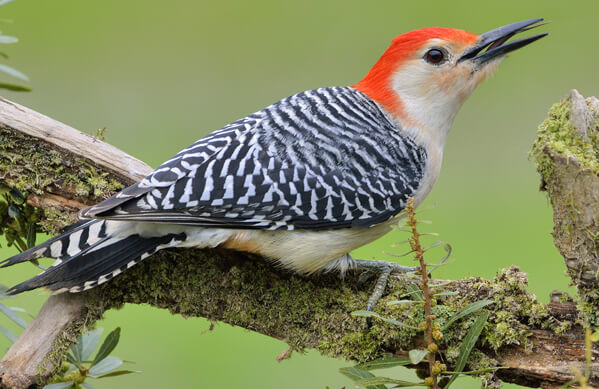Native Woodpeckers in Florida: An Overview to Species and Behaviors
Native Woodpeckers in Florida: An Overview to Species and Behaviors
Blog Article
Woodpeckers Unleashed: Exploring the Wonders of These Experienced Tree Mountain Climbers
Woodpeckers, with their distinct markings and balanced drumming resembling via wooded locations, hold a special location in the avian globe. Their specialized composition and adjustments allow them to navigate upright surface areas with unmatched skill. Their mastery of tree climbing is just one facet of their remarkable behavior. As we dive into the detailed information of woodpeckers' nesting practices, feeding techniques, and the recurring conservation efforts to safeguard these impressive birds, a deeper gratitude for their location in nature unravels.
Makeup and Adaptations
When taking a look at the anatomy and adaptations of woodpeckers, one can observe remarkable attributes that allow these birds to grow in their specialized ecological particular niche. In addition, woodpeckers have zygodactyl feet, with 2 toes encountering onward and 2 dealing with backward, supplying a firm grasp on tree trunks while they browse for food or drum for communication.
Additionally, woodpeckers have a distinct tongue framework that is long, barbed, and sticky, enabling them to extract insects from holes in timber. This customized adaptation allows woodpeckers to exploit a food resource that is inaccessible to several other bird varieties. On the whole, the makeup and adaptations of woodpeckers showcase the remarkable evolutionary remedies that have actually enabled these birds to grow in their arboreal environment.
Drumming Habits
Having actually discovered the makeup and adaptations of woodpeckers, the focus currently moves to comprehending their drumming habits, an unique aspect of their interaction and territorial displays. Drumming is an essential form of interaction amongst woodpeckers, serving multiple purposes such as establishing regions, bring in companions, and signaling alarm system. Each woodpecker varieties has an one-of-a-kind drumming pattern that aids individuals identify members of their own types and distinguish them from competitors or killers.
Woodpeckers create drumming sounds by rapidly pecking on resonant surfaces such as dead trees, energy poles, or also metal items, producing a collection of balanced beats. The strength and rate of drumming can vary based on the purpose; for circumstances, a rapid drumming sequence may indicate hostility towards burglars, while a slower and softer drumming pattern could suggest courtship (Woodpeckers in Florida). In addition, woodpeckers might change the frequency and period of their drumming to communicate certain messages effectively
Nesting Routines
Checking out the nesting routines of woodpeckers discloses remarkable insights into their reproductive behaviors and habitat selections. Woodpeckers are known for their distinct nesting preferences, typically excavating cavities in trees to create protected areas for raising their young. These tooth cavities offer not only as a nesting website however likewise as a protected refuge from predators and stormy weather.
Woodpeckers show a high level of fidelity to their nesting websites, commonly going back to the very same location time after time. This habits highlights the significance of appropriate habitat accessibility for their reproductive success. The selection of a nesting website is crucial for woodpeckers, with aspects such as tree species, elevation, and degeneration phase playing substantial functions in their decision-making process.
Surprisingly, some woodpecker species are understood to dig deep into several cavities within their area, giving themselves with alternate nesting alternatives. This strategy may function as a form of insurance coverage against possible risks or disruptions to their primary nesting website.

Feeding Strategies
One of the most unique feeding actions of woodpeckers is drumming, which entails rapid pecking on trees to reveal insects beneath the bark. Woodpeckers are also known to excavate cavities in trees to access surprise insect larvae or sap. Some types, like the acorn woodpecker, Going Here store nuts in particularly produced openings called granaries.
Conservation Initiatives
Amidst the complex feeding techniques exhibited by woodpeckers, the conservation initiatives focused on safeguarding these fascinating birds play an important duty in maintaining their environments and populations. Woodpeckers face numerous risks to their survival, consisting of habitat loss because of logging, environment adjustment altering dig this their ecological communities, and collisions with synthetic frameworks such as structures and automobiles - Woodpeckers in Florida. Guardians are actively working to address these obstacles and make sure the lasting well-being of woodpecker varieties

Education and learning and public recognition projects are also important components of woodpecker preservation efforts. By elevating understanding regarding the relevance of these birds in preserving healthy forest ecological communities, guardians can amass assistance for environment preservation initiatives and advertise liable land administration practices. Through joint initiatives between scientists, policymakers, and local communities, we can function with each other to protect a future where woodpeckers prosper in their natural environments.
Verdict

Report this page